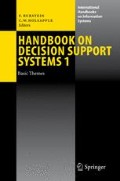Abstract
Collaboration has become more important to global organizations as they handle the increasing dispersal of their activities across space, time, and organizational boundaries. How to get dispersed teams of knowledge workers and decision-makers to work together in more efficient and effective ways has driven organizational adoption and use of collaborative technologies. In this article, we discuss the nature of team collaboration and provide an overview of collaborative technologies that allow members to cope with the opportunities and challenges of cross-boundary work. Included in this overview are messaging, conferencing, and team collaborative applications. We also discuss the emergence of integrated collaborative environments, as well as other issues and trends that are influencing the collaboration marketplace.
Access this chapter
Tax calculation will be finalised at checkout
Purchases are for personal use only
Preview
Unable to display preview. Download preview PDF.
References
AOL, “Top Trends in Communications,” in Third annual instant messaging survey, 2006. Available via http://www.aim.com/survey.
Boudreau, M., K. Loch, D. Robey and D. Straub, “Going Global: Using IT to Advance the Competitiveness of the Virtual Transnational Organization,” Acad Manage Exec, 12(4), 1998, 120-128.
Briggs, R.O., J.F. Nunamaker Jr. and R.H. Sprague Jr., “1001 Unanswered Research Questions in GSS,” J Manag Inform Sys 14(3), 1997, 3-21.
Burns, E., “Wireless e-mail Drives PDA Sales,” in ClickZ Stats, 2005. Available via http://www.clickz.com/stats/sectors/email/article.php/3503511.
Daft, R., R. Lengel and L. Trevino, “Message Equivocality, Media Selection, and Manager Performance Implications for Information Systems,” MIS Quart, 11(3), 1987, 355-366.
Dennis, A.R. and J.S. Valacich, “Towards a Theory of Media Synchronicity,” in Proc Hawaii Int Conf Syst Sci, 1999.
Deus, L., “Collaboration Marketplace Evolving to Meet Emerging Needs,” in The Edge Perspectives, Mitre, 2000. Available via http://www.mitre.org/news/edge_perspectives/february_00/ep_first.html.
Duarte, D. N. and Synder, Mastering Virtual Teams: Strategies, Tools, and Techniques That Succeed, San Francisco, CA: Jossey-Bass, 1999.
Fjermestad, J., and S. Hiltz, “An Assessment of Group Support Systems Experimental Research: Methodology and Results,” J Manag Inform Syst, 15(3), 1998, 7-149.
Driver, E., “Culture and Security are the Leading Barriers to Team Collaboration Adoption,” in Executive Summary, Emerging Trends, Forrester Research, 2005. Available via http://www.forrester.com/Research/Document/Excerpt/0,7211,37869,00.html.
Fulk, J. and B. Boyd, “Emerging Theories of Communication in Organizations,” J Manage, 1(2), 1991, 407-446.
Fulk, J. and G. DeSanctis, “Electronic Communication and Changing Organizational Forms,” Organ Sci, 6(4), 1995, 1-13.
Fulk, J. C. Steinfield, J. Schmitz and J. Power, “A Social Information Processing Model of Media Use in Organizations,” Commun Res, 14(5), 1987, 529-552.
Gartner Group, 2005. Available via http://www.gartner.com/press_release/asset_130169_11.html.
IDC, “Worldwide Integrated Collaborative Environments,” in 2005-2009 Forecast, 2005. Available via http://www.idc.com/getdoc.jsp?containerId=33278.
Jarvenpaa, S. and D. Leidner, “Communication and Trust in Global Virtual Teams,” Organ Sci, 10(6), 1999, 791-815.
Kratzer, J., R. Leenders and J. van Engelen, “Keeping Virtual R&D Teams Creative,” Res Technol Manage, 48(2), 2005, 13-16.
Langham, M., “Team Collaboration Applications,” in Research Report, Bloor Research, 2003. Available via http://www.bloor-re- search.com/research/research_report/555/team_collaboration_applications.html.
Majchrzak, A., R. Rice, A. Malhotra, N. King and S. Ba, “Technology Adaptation: The Case of a Computer-Supported Inter-Organizational Virtual Team,” MIS Quart, 24(4), 2005, 569-600.
Malhotra, A. and A. Majchrzak, “Enabling Knowledge Creation in Far-Flung Teams: Best Practices for IT Support and Knowledge Sharing,” J Knowl Manage, 8(4), 2004, 75-88.
Malhotra, A. and A. Majchrzak, “Virtual Workspace Technologies,” Sloan Manage Rev, 46(2), 2005, 11-14.
Malykhina, E., “Everyone Wants One,” in Information Week, 2005. Available via http://www.informationweek.com/story/showArticle.jhtml?articleID=175004871.
Massey, A.P. and M. Montoya-Weiss, “Unraveling the Temporal Fabric of Knowledge Conversion: A Model of Media Selection and Use,” MIS Quart, 30(1), 2006, 99-114.
Massey, A.P., M. Montoya-Weiss and C. Hung, “Because Time Matters: Temporal Coordination in Global Virtual Project Teams,” J Manag Inform Syst 19, 4, 2003, 129-156.
Marks, M.A., J.E. Mathieu and S.J. Zaccaro, “A Temporally Based Framework and Taxonomy of Team Processes,” Acad Manage Rev, 26(3), 2001, 356-376.
McDonough, E.F., “An Investigation of Factors Contributing to the Success of Cross-Functional Teams,” J Prod Innovat Manag, 17(3), 2000, 221-335.
McDonough, E.F., K.B. Kahn and A. Griffin, “Managing Communication in Global Product Development Teams,” IEEE Trans Eng Manag, 46(4), 1999, 375-386.
McGrath, J., “Time, Interaction, and Performance (TIP): A Theory of Groups,” Small Group Res, 22(2), 1991, 147-174.
Montoya-Weiss, M., A.P. Massey, Y. Hung and B. Crisp, “Can You Hear Me Now? Communication in Virtual Product Development Teams,” J Prod Innovat Manag, in press.
Montoya-Weiss, M., A.P. Massey and M. Song, “Getting it Together: Temporal Coordination and Conflict Management in Global Virtual Teams,” Acad Manag J 44(6), 2001, 1251-1262.
Powell, A., G. Piccoli and B. Ives, “Virtual Teams: A Review of Current Literature and Directions for Future Research,” Database Adv Inform Syst, 35(1), 2004, 6-36.
Robey, D., M. Boudreau and G.M. Rose, “Information Technology and Organizational Learning: A Review and Assessment of Research,” Account Manag Inform Tech, 10(1), 2000, 125-155.
Romano, N.C., F. Chen and J. Nunamaker, “Collaborative Project Management Software,” in Proc Hawaii Int Conf Syst Sci, 2002.
Short, J.A., F. Williams and B. Christie, The Social Psychology of Telecommunications, New York, NY: Wiley, 1976.
Stohr, E. and J.L. Zhao, “Workflow Automation: Overview and Research Issues,” Inform Sys Fron 3(3), 2001, 281-296.
Telecommunications Industry Association, 2006 Telecommunications market review and forecast. Arlington, VA: TIA, 2006.
Warkentin, M.E., L. Sayeed and R. Hightower, “Virtual Teams Versus Face-To-Face Teams: An Exploratory Study of a Web-Based Conference System,” Decis Sci, 28(4), 1997, 975-996.
Zack, M., “Interactivity and Communication Mode Choice in Ongoing Management Groups,” Inform Syst Res, 4(3), 1993, 207-261.
Author information
Authors and Affiliations
Rights and permissions
Copyright information
© 2008 Springer-Verlag Berlin Heidelberg
About this chapter
Cite this chapter
Massey, A. (2008). Collaborative Technologies. In: Handbook on Decision Support Systems 1. International Handbooks Information System. Springer, Berlin, Heidelberg. https://doi.org/10.1007/978-3-540-48713-5_17
Download citation
DOI: https://doi.org/10.1007/978-3-540-48713-5_17
Publisher Name: Springer, Berlin, Heidelberg
Print ISBN: 978-3-540-48712-8
Online ISBN: 978-3-540-48713-5
eBook Packages: Computer ScienceComputer Science (R0)

